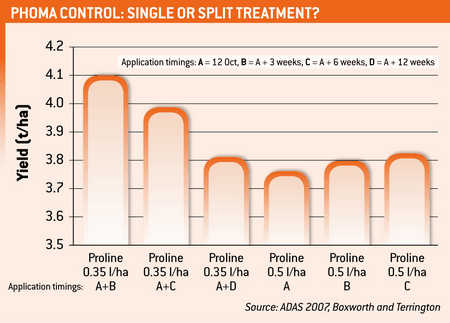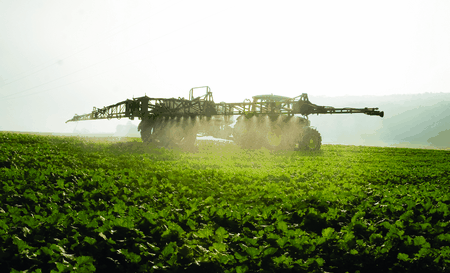OSR needs second spray to counter phoma threat

Oilseed rape growers could be losing £70/ha by not spraying twice in the autumn to control phoma, says Peter Gladders of ADAS.
His warning comes with crops likely to be approaching phoma spray thresholds of 10-20% plants infected, and on the back of trials results both last season and before showing more consistent yield results from two autumn spray programmes.
About 20 days of rain are required from 1 August to trigger phoma infections in oilseed rape, says Dr Gladders. “There were 13 days with rain at ADAS Boxworth during August, and with wet weather around last week, crops might get to thresholds soon.”
When thresholds are triggered, trials show it pays to apply two autumn sprays. On average over the past 10 years, two autumn applications at ADAS Boxworth have given a yield response of 0.35t/ha, with responses ranging from zero in 2000 to over 0.7t/ha in the high phoma year of 2002, Dr Gladders points out. “It is a sound strategy when you are going for consistent performance.”
That was also highlighted in specific timing trials last season carried out by ADAS for Bayer CropScience. In the trials, two well-timed autumn sprays of Proline yielded more than a single, higher-dose application (see graph).

The problem with a single spray is that it is difficult to predict which timing will be best, says Dr Gladders. For example, in the trial, the earliest timing (A) around 12 October was the lowest yielding, giving on average across the two sites 3.75t/ha, despite the sprays being applied after the 10-20% infected plant threshold was reached.
Later single timings in November yielded slightly more at about 3.8t/ha, showing there is some flexibility in timing, but the best two sprays split-timing yielded 4.1t/ha. “That approach is more consistent and robust,” he adds.
An extra 0.2 litres/ha of Proline (prothioconazole) was applied in the split treatments compared with the single 0.5 litres/ha applications, but that extra cost, about £7.50/ha, was easily paid for by the extra 0.35t/ha achieved. At current prices of over £225/t, the higher yield was worth over £70/ha after deducting fungicide costs.
However, timing was important when splitting the sprays last season, Dr Gladders notes. “Last year you didn’t want to be much more than four weeks apart.”
That was because fungicide persistence was not much more than three weeks following strong crop growth in mild conditions. “Normally it is around six weeks.”
Re-infection on new leaves started earlier, so the split treatments needed a tighter window – hence the follow-up timing three weeks after the initial spray gave the best yields. Delaying the follow-up treatment for 12 weeks until December lost virtually all of the additional yield benefit.
“The key is to check for re-infection,” Dr Gladders advises. “Last year a tight interval was best, but this year it might be longer. Look in barometer at-risk crops for the tell-tale little phoma spots.”

Growers should plan to spray for phoma twice this autumn.
| Phoma control |
|---|
|

